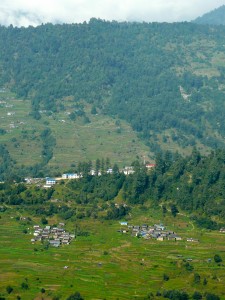The legal proceedings required Mahabir Pun and Ommaya to register the marriage at the local government office in Chitwan where they were issued a marriage certificate. One last step required Ommaya to file citizenship papers as Mahabir’s wife in the Office of Chief District Officer of Chitwan. This completed the legalities but not the social complexity.

Nangi in the foreground; Ramche in the background; and to the left, out of sight, would be Kaphaldanda.
There was no celebration of the marriage in a traditional post wedding party. In Mahair’s own words…“I am strictly against any kind of party or ceremony. Neither I give party to anybody nor I attend party or ceremony thrown by anybody.” I had attended a wedding reception 10 years ago in Nangi. Even in the small village it was a huge occasion. Multiple animals were slaughtered, hundreds of people came to eat and dance and it was a generally merry occasion…not unlike the atmosphere at our own western wedding receptions. But he would not have such friviolties. Mahabir described their celebration as a “gathering” of a few close relatives at his brother’s home in Chitwan. They simply ate dal bhat, which is the daily diet of most Nepalese.
Months later, to complete the social process, Mahabir and Ommaya went to visit her family in Kaphaldanda and brought gifts. This is called Dhog Garne and Mahabir described the process simply and elegantly…”in Nepali meaning bowing to the families and close relatives of the girl’s. According to the tradition, we went to meet Ommaya’s parents and relatives with some of my close relatives from Nangi. We took a goat as present and some Raksi. All the relatives gathered at Ommaya’s house and we bowed our heads to the people, whom we were supposed to respect. This simple ceremony gives formal and final approval of the marriage.”
According to Ommaya this was a love match, but Mahabir Pun had been under social and family pressures from his mother to marry even years before Ommaya was born. It is no coincidence the families knew each other, lived in the same district and were from the same ethnic group called Magars. It was a match that pleased all parties involved.
If you lived in a culture where your parents chose your mate, who do you think they would have chosen? Join me next week to read about Mahabir’s life as a husband and father.

” took a goat as present”
When I read of the giving of a goat, or any livestock, I am always intrigued. The value of an animal suitable for giving as a gift, would be high due to production costs and the loss of it as potential stock or food. In our non-agrarian society, it is hard to measure the value, but when I look at my little farmstead endeavors, I can only begin to imagine the value of such a gift.
And here is Viv’s amazing farm: http://lilachillfarmpa.com